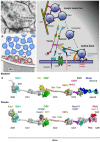Role of Bassoon and Piccolo in Assembly and Molecular Organization of the Active Zone
- PMID: 26793095
- PMCID: PMC4709825
- DOI: 10.3389/fnsyn.2015.00019
Role of Bassoon and Piccolo in Assembly and Molecular Organization of the Active Zone
Abstract
Bassoon and Piccolo are two very large scaffolding proteins of the cytomatrix assembled at the active zone (CAZ) where neurotransmitter is released. They share regions of high sequence similarity distributed along their entire length and seem to share both overlapping and distinct functions in organizing the CAZ. Here, we survey our present knowledge on protein-protein interactions and recent progress in understanding of molecular functions of these two giant proteins. These include roles in the assembly of active zones (AZ), the localization of voltage-gated Ca(2+) channels (VGCCs) in the vicinity of release sites, synaptic vesicle (SV) priming and in the case of Piccolo, a role in the dynamic assembly of the actin cytoskeleton. Piccolo and Bassoon are also important for the maintenance of presynaptic structure and function, as well as for the assembly of CAZ specializations such as synaptic ribbons. Recent findings suggest that they are also involved in the regulation activity-dependent communication between presynaptic boutons and the neuronal nucleus. Together these observations suggest that Bassoon and Piccolo use their modular structure to organize super-molecular complexes essential for various aspects of presynaptic function.
Keywords: Aczonin; Bassoon; Piccolo; actin dynamics; cytomatrix at the active zone; neurotransmitter release; synaptic vesicle; synapto-nuclear signaling.
Figures

References
Publication types
LinkOut - more resources
Full Text Sources
Other Literature Sources
Molecular Biology Databases
Miscellaneous

